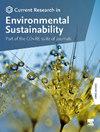Optimizing organic ginger cultivation: Evaluating growth behavior and production potential of HP 05/15 in eastern Himalayan Inceptisols
IF 3.7
Q2 ENVIRONMENTAL SCIENCES
Current Research in Environmental Sustainability
Pub Date : 2025-01-01
DOI:10.1016/j.crsust.2025.100287
引用次数: 0
Abstract
Can specific ginger genotypes thrive under organic farming (OF) in the acidic Inceptisols of Eastern Himalayas Region (EHR)? This study identifies HP 05/15 as the top performer in yield, quality, and soil health improvement. Over two years (2019–20 and 2020–21), field experiment was conducted involved ten different ginger genotypes with three replications. Results revealed that the lowest incidence of bacterial wilt disease (18.10 %) and maximum fresh rhizome yield (15.50 Mg ha−1) was found at HP 05/15. Meanwhile, significantly higher dry recovery (22.30 %) and crude fiber content (6.89 %) was recorded at Bhaise, followed by HP 05/15. At Bhaise, genotype HP 05/15 was noticed significantly higher (47.30 %) essential oil content and oleoresin (+43.20 % more) content followed by V0.5/2. Similarly, genotype HP 05/15 was registered the significant improvement of production efficiency (41.10 %) and profitability (43.30 %) as comparison to the Bhaise. In case of soil health improvement, genotype HP 05/15 cultivated plot was recorded ∼6.40 % reduced bulk density (pb), increased ∼13.40 % total water stable aggregates (TWSA), ∼6.35 % soil organic carbon (SOC), ∼12.80 % macronutrients, ∼13.50 % micronutrients and ∼ 14.90 % biological activity.
Overall, genotype HP 05/15 recommended for organic farming (OF) cultivation due to its high yield, disease resistance, essential oil content, profitability, and positive effects on soil health improvement, making it ideal for sustainable cultivation in the Eastern Himalayas Region .

优化有机生姜栽培:评价HP 05/15在喜马拉雅东部地区的生长行为和生产潜力
在东喜马拉雅地区(EHR)酸性土壤中有机耕作(OF)下,特定的生姜基因型能否茁壮成长?本研究确定HP 05/15在产量、质量和土壤健康改善方面表现最佳。在2019 - 2020年和2020-21年的2年时间里,对10个不同生姜基因型进行了3个重复的田间试验。结果表明,HP 05/15的青枯病发病率最低(18.10%),鲜根茎产量最高(15.50 Mg ha−1)。同时,Bhaise的干回收率为22.30%,粗纤维含量为6.89%,HP 05/15次之。Bhaise品种中,HP 05/15基因型的挥发油含量和油树脂含量分别显著高于47.30%和43.20%,其次是V0.5/2基因型。同样,与百色相比,基因型HP 05/15的生产效率(41.10%)和盈利能力(43.30%)显著提高。在改善土壤健康的情况下,基因型HP 05/15栽培地块的容重(pb)降低了~ 6.40%,总水稳定团聚体(TWSA)增加了~ 13.40%,土壤有机碳(SOC)增加了~ 6.35%,宏量营养素增加了~ 12.80%,微量营养素增加了~ 13.50%,生物活性增加了~ 14.90%。总体而言,HP 05/15基因型因其高产、抗病、挥发油含量高、盈利能力强以及对土壤健康改善的积极作用,推荐用于有机农业(OF)种植,是东喜马拉雅地区可持续种植的理想选择。
本文章由计算机程序翻译,如有差异,请以英文原文为准。
求助全文
约1分钟内获得全文
求助全文
来源期刊

Current Research in Environmental Sustainability
Environmental Science-General Environmental Science
CiteScore
7.50
自引率
9.10%
发文量
76
审稿时长
95 days
 求助内容:
求助内容: 应助结果提醒方式:
应助结果提醒方式:


